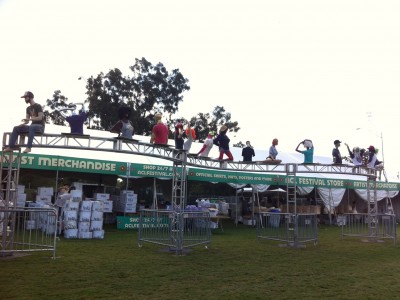Event and Artist Merchandise Guide
Merchandise can be a key source of income and branding for festivals and events. When done well, items can sell out quickly and build a positive buzz surrounding the event. Part of ensuring the guests can view and purchase merchandise is making sure the Merchandise team properly coordinates with the Site Operations department so they have everything (tent, tables, chairs, power, lighting) they need. Most events also utilize a couple of flatbed golf carts to help shuttle the boxes of merch around, especially if artists are selling merchandise.
Event / Festival Merchandise:
- Determining what sort of merchandise to offer
- T-Shirts
- Hats
- Koozies
- Hoodies
- Pants
- Kid’s Items
- Pet Items
- Posters
- Commemorative Books
- Jackets
- Polos / Dressier Apparel
- Socks
- Headbands / Armbands
- Gloves
- Toys
- Working with the Creative department to produce designs and have them approved by all major stakeholders
- Selecting a third party vendor to produce the merchandise
- Make sure you understand their deadlines as they can be up to several weeks prior to the event; this may put pressure on Creative / Event Owners to decide on their branding before they may have everything in place. Some first year events go light on merch to be safe on the investment, but also because they may not have everything finalized branding-wise.
- There are several nationwide vendors that can come in and handle merchandise fulfillment; these companies can do everything from counting-in all given merchandise, properly displaying it, handling all cash and credit card transactions, and then handing you a settlement report that details the remaining inventory and how many of each item sold.Selecting a third party vendor to manage the merchandise on-site
- Setting up your merchandise area

Setting up the Merch Tent at ACL Fest 2013
- Having staff count-in the merchandise and fill out all proper accounting
- If you don’t have a third-party vendor manage, you will need to have staff on-site to over see it. The major elements are:
- Counting in all inventory
- Having a spreadsheet that lists all inventory, their prices, and how much of each
 Download the Excel Version of the Merchandise Count-In Sheet
Download the Excel Version of the Merchandise Count-In Sheet - Updating that list as things sell (or doing a batch update at the end of the night)
- Being set up to take not just cash, but credit card payments as well
- If you do not have a merchant account set up with a credit card terminal (similar to what you’d see at a store), you can sign up for an account that accepts credit cards via a company like Paypal, and they will even give you a swiping device to put on your phone so you can swipe their card.
- Counting out all remaining inventory and updating all quantities in the master spreadsheet
- Updating all income, taking into account all credit card fees paid (usually it’s around 2.9% plus a small transaction fee, usually $.15-$.30 per transaction – your financial institution or credit card service provider can provide you with the details.
- If you don’t have a third-party vendor manage, you will need to have staff on-site to over see it. The major elements are:
Artist Merchandise:
- Determining whether the artist or venue sells
- If artist sells, provide them with a space to sell their merch
- Usually a table with a power cord, some chairs, shade, and perhaps a metal grid to hang up items will be sufficient for most artist merch needs.
- Common splits are 80% artist / 20% venue for all soft goods (t-shirts, stickers, hats), 90% artist / 10% venue for any recorded media (CDs, DVDs, Vinyl). This is normally negotiated in the Talent Buying phase of the event production.
- Depending on the size of your event and if you’re selling or if the artist is selling, it may be easier to give all revenue to the artist – it’s one less thing to worry about and it gives the artist a little bit more money.
- If venue sells, have the artist provide staff with the inventory, count-in sheets, and anything else needed
- At the end, settle with the artist rep if there are any splits. Otherwise, provide them with their inventory counted back out along with any updated settlement sheets.
- If artist sells, provide them with a space to sell their merch


